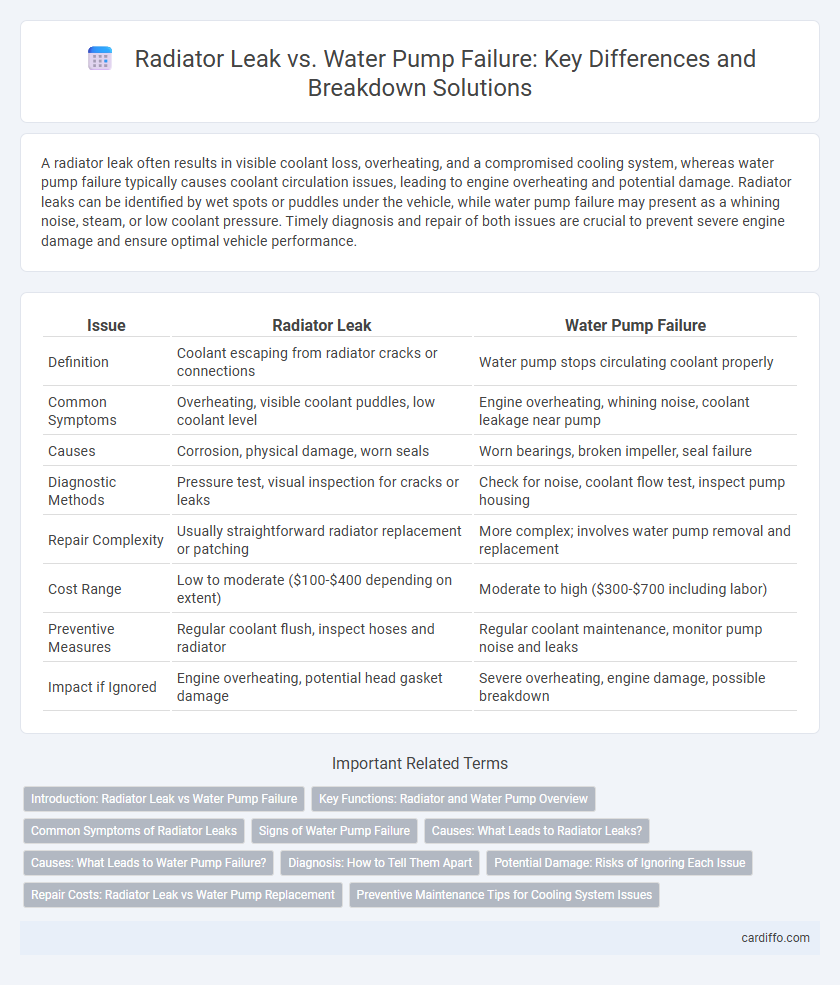A radiator leak often results in visible coolant loss, overheating, and a compromised cooling system, whereas water pump failure typically causes coolant circulation issues, leading to engine overheating and potential damage. Radiator leaks can be identified by wet spots or puddles under the vehicle, while water pump failure may present as a whining noise, steam, or low coolant pressure. Timely diagnosis and repair of both issues are crucial to prevent severe engine damage and ensure optimal vehicle performance.
Table of Comparison
| Issue | Radiator Leak | Water Pump Failure |
|---|---|---|
| Definition | Coolant escaping from radiator cracks or connections | Water pump stops circulating coolant properly |
| Common Symptoms | Overheating, visible coolant puddles, low coolant level | Engine overheating, whining noise, coolant leakage near pump |
| Causes | Corrosion, physical damage, worn seals | Worn bearings, broken impeller, seal failure |
| Diagnostic Methods | Pressure test, visual inspection for cracks or leaks | Check for noise, coolant flow test, inspect pump housing |
| Repair Complexity | Usually straightforward radiator replacement or patching | More complex; involves water pump removal and replacement |
| Cost Range | Low to moderate ($100-$400 depending on extent) | Moderate to high ($300-$700 including labor) |
| Preventive Measures | Regular coolant flush, inspect hoses and radiator | Regular coolant maintenance, monitor pump noise and leaks |
| Impact if Ignored | Engine overheating, potential head gasket damage | Severe overheating, engine damage, possible breakdown |
Introduction: Radiator Leak vs Water Pump Failure
Radiator leaks and water pump failures are common causes of engine overheating and breakdowns in vehicles. A radiator leak typically results from corrosion, physical damage, or worn hoses, leading to coolant loss and reduced cooling efficiency. Water pump failure, often caused by bearing wear or seal damage, disrupts coolant circulation, causing engine overheating and potential severe engine damage.
Key Functions: Radiator and Water Pump Overview
The radiator functions as a heat exchanger, dissipating engine heat by circulating coolant through the engine block. The water pump plays a crucial role by forcing coolant to flow through the engine and radiator, maintaining an optimal operating temperature. A radiator leak causes coolant loss, leading to overheating, while water pump failure disrupts coolant circulation, resulting in engine overheating and potential damage.
Common Symptoms of Radiator Leaks
Radiator leaks often present common symptoms such as visible coolant puddles beneath the vehicle, overheating engine temperatures, and a sweet smell of antifreeze. Drivers may also notice low coolant levels despite frequent refills and steam emanating from the engine bay. These indicators are crucial for distinguishing radiator leaks from water pump failure, which typically involves whining noises and coolant circulation issues.
Signs of Water Pump Failure
Signs of water pump failure include coolant leaks around the pump, engine overheating, and a whining or grinding noise coming from the front of the engine. A failing water pump often causes low coolant levels and visible steam or puddles beneath the vehicle. Early detection of these symptoms is critical to prevent engine damage and costly repairs.
Causes: What Leads to Radiator Leaks?
Radiator leaks typically result from corrosion caused by prolonged exposure to coolant and contaminants, creating weak spots in the radiator's metal or plastic components. Physical damage from road debris or impact can also puncture or crack the radiator, leading to leaks. Improper maintenance, such as using incorrect coolant or neglecting to flush the cooling system, accelerates deterioration and increases the risk of radiator leaks.
Causes: What Leads to Water Pump Failure?
Water pump failure often results from worn-out bearings, which cause the pump to seize or leak coolant. Corrosion or buildup of debris within the cooling system can damage the pump impeller, reducing its efficiency and leading to overheating. Additionally, a broken or slipping drive belt interrupts the pump's operation, directly causing water pump malfunction.
Diagnosis: How to Tell Them Apart
Radiator leak diagnosis involves inspecting for visible coolant puddles, low coolant levels, and steam or wet spots around the radiator or hoses, while water pump failure is often identified by a high-pitched whining noise, overheating engine, and coolant seepage near the water pump gasket. Pressure testing the cooling system can reveal radiator leaks by dropping pressure, whereas a failing water pump may cause coolant to circulate poorly despite maintained pressure. Checking for play or grinding in the water pump pulley helps differentiate pump failure from a radiator leak.
Potential Damage: Risks of Ignoring Each Issue
Ignoring a radiator leak can lead to engine overheating, causing severe damage such as a blown head gasket or warped engine components. Water pump failure disrupts coolant circulation, resulting in rapid engine temperature rise and potential engine seizure. Both issues demand immediate attention to prevent costly repairs and maintain vehicle reliability.
Repair Costs: Radiator Leak vs Water Pump Replacement
Radiator leak repair costs typically range from $300 to $900, depending on the severity and labor involved, while water pump replacement can cost between $400 and $750 due to part complexity and installation time. Radiator leaks often require coolant flushes and possible hose replacements that add to expenses, whereas water pump failure necessitates timely replacement to prevent engine overheating and further damage. Understanding these cost differences aids in budgeting vehicle maintenance and prioritizing urgent repairs.
Preventive Maintenance Tips for Cooling System Issues
Regularly inspecting the radiator for cracks, corrosion, and leaks helps prevent cooling system breakdowns and maintains optimal engine temperature. Replacing coolant fluid at manufacturer-recommended intervals reduces the risk of water pump failure caused by corrosion or bearing wear. Ensuring the integrity of hoses, belts, and clamps during routine maintenance supports both radiator and water pump functionality, minimizing costly repairs.
Radiator leak vs water pump failure Infographic

 cardiffo.com
cardiffo.com